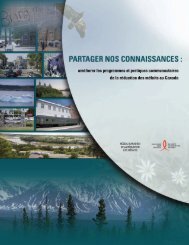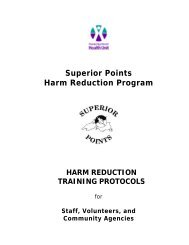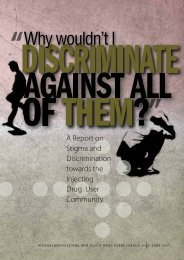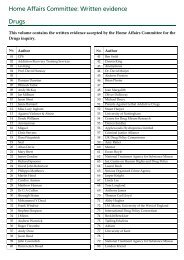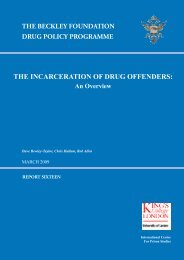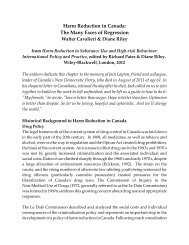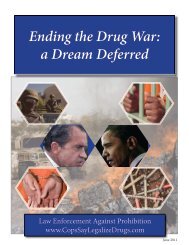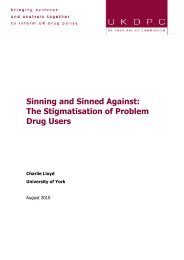NEWSLETTER - Canadian Harm Reduction Network
NEWSLETTER - Canadian Harm Reduction Network
NEWSLETTER - Canadian Harm Reduction Network
Create successful ePaper yourself
Turn your PDF publications into a flip-book with our unique Google optimized e-Paper software.
Toronto <strong>Harm</strong> <strong>Reduction</strong> Task Force“…working to reduce drug related harm in Toronto, since 1996”<strong>NEWSLETTER</strong>www.torontoharmreduction.orgVolume 5, Issue 2, Summer/Fall 2003Legal clinics serve homelessOffer a roster of 'sensitive' lawyersDrop-in program a one-year pilotTRACEY TYLERLEGAL AFFAIRS REPORTERFrom the Toronto StarThey start arriving around noon at All Saints Anglican church. And when their turn comes, theywalk past carved oak choir stalls and take a seat behind the screen.They're not looking for absolution, just a little advice.The men and women heading into the Dundas St. E. sanctuary every second Wednesday comewith legal problems ranging from criminal charges to the threat of losing their children —devastating by themselves, but even harder to deal with when you have no permanent home, nojob and, sometimes, not enough to eat.People in their shoes often give up — opting to plead guilty or let their children become crownwards — because they don't appreciate they have legal rights, says Anita Barnes, a communitylegal worker trying to change that through a program known as Outreach Legal Services, set upto deliver legal aid to the homeless in Toronto.Eight months into a year-long pilot project, the program has served 350 clients at drop-in clinics atfour downtown locations. "This is our busiest site by far," Barnes says, standing beside hermakeshift office, beneath a vaulted wooden ceiling in front of the altar.Barnes and criminal lawyer Yukimi Henry have teamed up to run the program, funded by LegalAid Ontario and operating as a branch of Neighbourhood Legal Services, a community legal clinicon Queen St. E.Henry usually represents clients at their bail hearings, but more complex matters, including trials,are often referred out to lawyers in private practice, Barnes says.In addition to $184,000 in funding for the clinic, Legal Aid Ontario has agreed to issue legal aidcertificates to virtually any clinic clients whose cases are handled by the private bar.Barnes says she and Henry have developed a roster of lawyers who are "sensitive" and receptiveto representing the homeless.But referring clients to outside lawyers isn't simply "a drop job," she adds. Once a legal aidcertificate is issued, either she or Henry will accompany a client to the lawyer's office. "For themto walk into a law firm on Bay Street would be overwhelming," she says.Barnes and Henry also continue to act as liaisons and make sure clients show up for court.Sometimes, Barnes rides around on her bike looking for people. One man she found on a parkbench.Frequently, things don't go smoothly. Clients are often wary of the clinic's ability to help becausethey've been given the runaround by bureaucrats or authority figures in the past, says Barnes. "Ican totally understand how many have trust issues with the legal system, because they've beenlet down and screwed around."Toronto <strong>Harm</strong> <strong>Reduction</strong> Task Forcewww.torontoharmreduction.org
Sometimes, it takes five or six visits before they feel comfortable enough to discuss their legalproblem, she says. "The first time, they might just come to say hi."Kate, who didn't want her real name used, came looking for reassurance that she won't beassuming an undue risk by taking a job.After years on social assistance and living in shelters, she's found part-time work, 12 to 15 hoursa week, as a clerk in the meat and fish department of a grocery store and plans to go back toschool to become a registered practical nurse.But she heard rumours on the street that her access to benefits will be cut off three months afterbecoming employed. She says she's been on a disability pension and wants to make sure shecan stick with the job. If it doesn't work out, she fears she'll end up on the street."When you're in my situation, you can become homeless at any time," she says. "You're alwaysjust a step away from the curb."Meanwhile, Robert, 47, who works as a maintenance man and gardener at the church, turned tothe program for help with criminal charges. He was living in Winnipeg but ended up in Toronto,where he bought drugs from an undercover officer in an alley. He says he was charged with drugpossession, assaulting police and resisting arrest.A well-known criminal lawyer, who represented him in the past, would take the case only if heagreed to a deal worked out with the prosecution, which involved pleading guilty and getting threemonths in jail, he says.Robert says he didn't want to accept the deal because he didn't assault police. While sitting in theToronto (Don) Jail, he heard about the clinic from the church minister. The clinic ended up takinghis case and he ended up with time served, which by that time was four months in jail.Still, he's happy. He can't get over the fact that when he was released from the Toronto WestDetention Centre in Etobicoke, where he was transferred toward the end of his sentence, Henrywas there to meet him and help him find his way back downtown.The clinic isn't the first attempt to help the homeless with their legal problems. In most major U.S.cities over the last 10 years, lawyers have set up programs through state or local bar associationsto offer non-criminal legal aid services to the homeless. And in Toronto, legal aid services for thehomeless have been offered through other Toronto legal clinics and community agencies, suchas the YMCA.Three years ago, however, Legal Aid hired two researchers who consulted with 100 homelesspeople to see if there was a need for "more accessible" and "more approachable" legal servicesin Toronto. In doing so, researchers Jacques Tremblay and Jim Ward looked at the experienceshomeless people had in seeking legal assistance up to that point and concluded it was notentirely positive.Some said they didn't bother to use lawyers because they could do better themselves. One mansaid he ended up with three months in jail and three years probation for stealing socks. Another,however, said he's used the same lawyer for 15 years and "he's like a member of the family."Some were deterred from seeking legal aid because they believed there was a $25 applicationfee. Others stressed that lawyers wanting to work with the homeless need to "dress down."The Metro <strong>Network</strong> for Social Justice and theToronto Civic Action <strong>Network</strong> (TorontoCAN!) present:The 3rd Annual MNSJ Activist Awards Dinner& The Launch of the 2nd Annual People's SummitFRIDAY, OCTOBER 3rd6pm Reception & Silent Auction6:30pm Dinner & SpeechesRALPH THORNTON CENTRE 765 Queen Street East (2 blocks east of Broadview)Tickets are $25 each (Full Tables Available)Call MNST at 416-703-3796 or mail cheques to 25 Leonard Avenue, Box 44, TO, ON, M5T 2R2This is an alcohol-free event. Subsidized tickets available; wheelchair accessible.Toronto <strong>Harm</strong> <strong>Reduction</strong> Task Forcewww.torontoharmreduction.org
RESPIRATORY ILLNESS & FRONT LINE WORKSouth Riverdale Community Health Centre ~ 955 Queen St. EastFOR HARM REDUCTION WORKERS IN TORONTOPresenters: Janet Meyer & Dr. Roy MaleTelephone: 416 461 1925, EXT. 253 Fax: 416 469 3442Email: rmale@srchc.comDate: Monday, September 22, 2003, 2:00 to 4:00 p.m.* Febrile Respiratory Illness* Brief Presentation on SARS* Brief Presentation on Tuberculosis* Very Brief: TB Infection Vs TB Disease* Simple screening procedure* Hand Washing* Preventive Aspects: Worker Safety/RoleTO INCREASE AWARENESS AMONG HARM REDUCTION OUTREACH WORKERS ABOUTFEBRILE RESPIRATORY INFECTIONS INCLUDING TUBERCULOSIS & SARS; TO REVIEWMETHOD OF REDUCING THE RISK OF INFECTION WHILE CARRYING OUT WORKFREE WORKSHOP FOR THOSE WHO WORK OR VOLUNTEER WITH THEHOMELESS OR UNDERHOUSEDThe Many Faces of HomelessnessThursday, September 25, 2003- 9:00 – 12:00 NoonScarborough Civic Centre - 150 Borough DriveNext to the Scarborough Town Shopping CentreExit at the Scarborough Centre RT Subway StationThe workshop will provide an overview of the many different communities who make up‘the homeless and underhoused’ and suggest actions and activities to address theunderlying issues and causes. The speakers include:• Jack Layton: Community Activist, Author and Leader of the Federal New DemocraticParty• The Dream Team: Psychiatric consumer survivors and other users of supportivehousing• Pilar Martin: Administrator/Counsellor, Emily Stowe Shelter for Women• Paruvathy Kanthasamy: Community Support Officer, Community ResourcesConsultants of TorontoPlease register me!__________________________________________________________NameAgency__________________________________________________________Telephone Fax e-mailComplete and return by fax to: (416) 285-5410 or e-mail to: s.h.h.c@bellnet.caToronto Public Health & Toronto Hostels Training CentreToronto <strong>Harm</strong> <strong>Reduction</strong> Task Forcewww.torontoharmreduction.org
Present:“Can I Catch This?”Communicable Disease & Tuberculosis Prevention WorkshopA free half-day workshop for organisations that work directly with Toronto’shomeless and underhoused community.Topics to be covered:• How infections are transmitted• How to protect yourself and others• What is SARS• What is TB• The role of Toronto Public Health in Communicable Disease Control• Bring your questions!Date: Wednesday, October 1, 2003Time: 9:00 a.m. – 12:00 Noon (Registration starts at 8:30 a.m.)Place: Metro Hall, 55 John Street, Room 308/309Morning coffee/snack will be providedWho should attend?Management, health and safety representatives, health care providers, front-linestaff and volunteers who work with homeless and underhoused people.Registration FormTo register: Please complete the following form and fax it to 416-469-5313 byFriday, September 19, 2003. If you have any questions, please call 416-469-0007Ext. 25. Confirmation of registration will be faxed to you. Space is limited.Name: _______________________ Agency: ______________________Telephone:____________________ Fax:_____________________Email: _______________________The ultimate lesson all of us have to learn is unconditional love,which includes not only others, but ourselves as well.~ Elizabeth Kubler-RossToronto <strong>Harm</strong> <strong>Reduction</strong> Task Forcewww.torontoharmreduction.org
Developer's simple idea could end housing woesBy John Barber: From the Globe & MailIf developer Mike Labbé were a better salesman, he wouldn't bury the most compelling slide in thepresentation he is working up to market his latest brainwave -- a fund that will invest in Toronto's stillhot housing market.It's the one that shows how much the buildings he has already built have appreciated in value, inevery case smartly outperforming the average increase in residential real estate in Toronto. Mr.Labbé not only buries the best evidence of his past success way down in the Powerpoint pile, hehas doctored it to exclude his most successful project to date, a condominium building on LawrenceAvenue West. The new Shermount is appreciating in value so quickly, he said, it would look"ridiculous" on the graph.Instead of dwelling on his successful track record as a developer, Mr. Labbé focuses on anotherslide with a message that's closer to his heart. It's the one that shows there are 5,000 children livingin homeless shelters in Toronto. Doing something about that -- not making money -- is the realpurpose of his new fund."The goal here is to solve the housing problem," Mr. Labbé said yesterday in his Queen Street Eastoffice. "I'm bound and determined to do that and this is an excellent way of getting there."This entrepreneur is not just touting another real-estate scheme on Bay Street; more importantly,he's planting the seeds of what he confidently expects will become a social revolution.The revolution is already apparent in buildings such as the Shermount, where people of modestmeans have been able to buy two-bedroom, 800-square-foot apartments for $1,140 a month in all --almost exactly what it costs to rent similar accommodation in Toronto. No other builder in Toronto,with or without government aid, has been able to make housing so affordable.According to the traditional government programs currently being implemented, a new rentalbuilding would need subsidies of $50,000 a unit -- amounting to $21-million for a building the size ofthe Shermount -- to achieve the same level of affordability.However, the Shermount would never qualify because its residents are owners, not tenants. Andinstead of government largesse, they benefited from low-cost marketing, basic design and highlyattractive financing from Mr. Labbé's non-profit company, Options for Homes.Another key difference between Mr. Labbé's projects and their subsidized equivalents (whichc rrentl e ist more in theor than fact) is that e er time his c stomers make their mortgageToronto <strong>Harm</strong> <strong>Reduction</strong> Task Forcewww.torontoharmreduction.org
payments, they contribute directly to a Home Ownership Alternatives, a fund that uses the money tobuild more affordable housing on the same model in new locations.Unwilling to change and "undermine" his successful system by accepting government grants, Mr.Labbé is counting on corporate Canada to provide the additional capital Home OwnershipAlternatives needs to make a real difference -- in effect to build Shermounts across the country.The idea, he said, was inspired by an Ursuline nun and fleshed out with the help of Dino Chiesa, aformer housing bureaucrat who is now president of Resreit, one of the largest real-estate incometrusts in Canada.The fund is structured to give investors a guaranteed 3-per-cent return over a period of 10 years,plus a prorated share of any appreciation in a project's property values. At the same time they willbe contributing directly to the rapid construction of some of the most truly affordable housing inCanada -- not just units but new homes that people buy. And if they want to accept a lower return,their money can be used to help families with commensurately lower incomes."Investors will have to care about housing, because this doesn't have any history to it," Mr. Labbéallowed. But for investors with a smidgeon of social conscience, the fund should prove irresistible.He figures even governments will see the light eventually."All we're saying is, 'Give us a loan and we'll repay you on an agreed-upon basis,' " Mr. Labbé said.And, in the meantime, you will help fundamentally to improve the ability of working people to owntheir own homes."Who's going to be the first through the door?" Mr. Labbé wondered. "That's the big challenge."jbarber@globeandmail.caOn Peer Work~ Greg LebelleRecently after co-writing the Peer Manual for the Toronto <strong>Harm</strong> <strong>Reduction</strong> Task Force, I havefound myself contemplating what seems to be that perennial (and personal) dilemma found within<strong>Harm</strong> <strong>Reduction</strong> employment: When does a peer stop being a peer, and when is a serviceprovider finished being a service provider? Are we/they on a specific clock, like say Sam andRalph in the sheep-dog/wiley-coyote cartoons I remember from my childhood Saturdaymornings? Do we just suddenly stop ‘being’ when we book off of our shift?<strong>Harm</strong> <strong>Reduction</strong>, indeed, any service that provides assistance to any marginalized groupis, in my opinion and experience, a calling. I believe it takes a certain type of person to do thework that we do, at a pittance of the wages, benefits, or respect our colleagues in lessmarginalizedareas of the health care or social services may receive. Sort of like the differencebetween what a Los Angeles plastic surgeon might earn versus what a Saint Michael’sEmergency Room intern might get. It takes a special type of person to be constantly challengingones own biases, predispositions, and knowledge base within a field that may be morechallenging with its constant changing than even, say brain-surgery, or rocket science, or judiciallawNew information, new precedents, new legislation all constantly change the face of <strong>Harm</strong><strong>Reduction</strong> in every community, province, and country across our planet that is liberal andforesighted enough to have such institutions as Public Health utilizing <strong>Harm</strong> <strong>Reduction</strong> policies orphilosophies.My colleague and friend, Walter Cavalieri once told me that case studies/scenarios arecommon debate fodder amongst Social Work undergrads, and even more so in studies to acquireToronto <strong>Harm</strong> <strong>Reduction</strong> Task Forcewww.torontoharmreduction.org
advanced degrees. They are also key in educating peer/employees at the onset of their work. Asa long time drug user and <strong>Harm</strong> <strong>Reduction</strong> practitioner and philosopher in the Toronto downtowncore, I am constantly witnessing real-life scenarios that could well challenge the minds of HRphilosophers.I know a guy…lets call him Sparky. He works at a daytime drop-in shelter as a FloorSupervisor. Although he doesn’t have a degree in Social Work, he has worked at that agency forover 10 years, and is a valuable asset to both the agency, and to the community he serves. Nowone of the reasons ‘Sparky’ was initially hired at that agency was because that when he appliedfor that job years and years ago, he knew the community: I guess the social demographics, asour educated friends might call it. ‘Sparky” was familiar with not just the community, but also mostof the area’s characters; the social problems, drug trade, and all the other colloquial quirks andfoibles of that neighborhood that gave it a special personality.‘Sparky’ was born and raised and lived all of his life in Regent Park. He was borndowntown, raised around Sumach and Queen, went to school there. He also had his first drinkthere, smoked his first joint there, and lost his virginity there with a high school sweetheart. Hestill lives in that neighborhood, and is both well known and well liked in the community. RegentPark is his turf, his community.Now hypothetically my question is: when does Sparky stop being a Regent Parker, andstart being a service provider? And vice versa?Hypothetically:• If Sparky’s drinking buddy of 15 years, Bubba needs the service of the drop-in, does theirpersonal relationship suddenly need to end?• If Sparky’s long time pot dealer, Gepetto, suddenly gets busted, does 6 months at theDon Jail, subsequently losing his apartment, upon release, can he go to his friend’sdrop-in and request assistance? And will he be getting assistance from a friend, or aservice provider? And what if Gepetto asks Sparky to float him a few bucks, or if he canspend a couple of weeks on his couch until he gets a place? After all, they have beenfriends for 15 years…• If Sparky and his high school Sweety meet at their 15-year High School Reunion, and gettogether, then later, Sweety requires one of the unique services of the drop-in, can shego to that same drop-in her beau runs?I think it fair to say that most in the ‘business’ would agree all of these situations are feasible. (Infact, ‘Sparky’ is simply a composite of several people I know working in similar environments, whoindividually have faced the scenarios outlined above.) I think that most would also agree they seevery few problems in any of those scenario’s, given the facts and circumstances leading up toeach situation.That said, we have fodder for more debate.What if these details were added:• What if Sparky’s friend in the second scenario, Gepetto, got busted while sellingpot to Sparky?• What if Gepetto wasn’t selling pot, but crack cocaine? Would that change youranswer? (Be honest folks)• What if Sweety had for a period of time been a prostitute, and was trying to getout of that lifestyle?On deeper levels of involvement, all of the above bring out very sensitive issues inservice provision which include boundary issues, ethics, relationships/sexual issues, and, ofcourse dealing with illicit drugs, including biases with different TYPES of illicit drugs.Does employment in a peer-type program mean one must separate oneself from thecommunity to provide service? And if so, to what degree of separation? I believe it is importantto remember that the user/peer has used this community as a personal support form him/herselffor much longer than he has used the hiring agency as a support. Also, agency supportoftentimes may end upon termination of the employment; then what of the peer/user? Can s/here-bridge that separation? Or will s/he be left without any support?Toronto <strong>Harm</strong> <strong>Reduction</strong> Task Forcewww.torontoharmreduction.org
Many people might not acknowledge or comprehend what we -- peers, or users, or exusers;must continually face: that our ‘circle’, our ‘inner sanctum’, our ‘hood’ is smaller than onemight think. And for obvious reasons: using illicit drugs, by definition, is illegal! It is much safer fora drug user to purchase drugs from a ‘reputable’ dealer; one s/he has bought from in the past;rather than risk exposure through a stranger to a potential narc. Also, a basic HR tenet is to limityour suppliers not only to protect your exposure to Johnny Law, but also the hospital emergencyroom or welfare line, as different dealers may sell with different ‘cuts’, or additives, or quality, tosay nothing about getting ‘vic-ed’ (getting ripped-off from a dealer who you don’t know, and whodoesn’t know you). Being a good drug dealer in one respect means being a prolific one. But thatmeans it may be possible, in fact, probable, that the peer and the service community would sharea dealer.Therefore service provision from peer workers is often much more complicated,befuddling, and confused than the relative ‘cut and dried’ boundaries of our counter-parts, serviceproviders coming from the educated social-service field, and not being a part of the drug usingcommunity. We often live and use within the same community in which we are also serviceproviders. If we didn’t, our effectiveness as peers would be greatly diminished.I remember working at a youth agency when I first got into this type of work. It was aChristian organization, and one for which I had a lot of respect. I felt somewhat privileged when Ifirst started working there, without any other qualifications than my ‘sordid’ past. Affectionately,and somewhat appropriately, I was nick-named by many youth and some of the staff as “theworlds oldest street-kid”.Very early in my ‘peer career’, one of my first challenges involving ‘boundaries’ was witha young male whom I had a particular fondness for. I had also known, from my ‘old’ yahoo days,his father, as well as a couple of his uncles (in fact, I had done time with one of them). Truth betold, the kid reminded me a little of myself as a youth. After assisting him with an employmentsearch he finally got a job interview! I may have been just as excited as he was!The problem was, he didn’t really have much in the line of presentable clothing. So Imade arrangements with him to meet him after work, and gave him some old clothes I had, aswell as a pair of shoes, two bus tickets, and a few bucks. The money or the clothing WAS NOT aloan but a gift (because I knew his father), and I made it quite clear that that was the case. I alsoagreed to hang on to his garbage bag of possessions until the next day after the interview…Now comes the crunch:Two days later the youth comes in to the agency, excited about starting his new job laterin the week. He mentions that he needs to come over to my apartment after work to get his stuff.One of the staff overhears, and the next thing I know, I receive a call to meet the “Big Boss” in the‘office upstairs’Most folks can probably guess what happened next: the discussion on healthyboundaries; the gift of the money; having the youth accompany me home to retrieve hispossessions; etc etc etc. Don’t get me wrong: the tone of the boss’s speech wasn’t punitive ordisciplinary. It was more like an Anthony-Robbins-type info-mercial for social work success! Ilearned much that day about ‘boundary etiquette’. After the lecture, I was offered the chance toask questions.Now I had just received a flurry of excellent information, and was trying to absorb andassimilate it, and wasn’t really ready to respond, so my eyes wandered to an embroidered plaqueon her wall which read, “ WWJD?”. (for my secular friends: “What Would Jesus Do?”).My Boss noticed this and, suddenly, it felt that a certain onus, or burden had passed fromme, the ‘peer’, to my Boss, the service provider in a ‘Christian’ agency (that whole: do unto othersas you would have them do unto you!). Suddenly, the excellent social work info-mercial I had justminutes before listened to became just a tad surreal; a philosophical dilemma/potato. Withoutbelabouring this any further, my Boss then closed her office door, gave me a hug, and confidedthat had she been in my shoes, she would have likely done the very same thing I had, and that inthe past she had done similar.What was only 15 minutes before clearly defined, clearly outlined, clearly clear, becameclear as mud.As is much of the work of a peer in harm reduction.Toronto <strong>Harm</strong> <strong>Reduction</strong> Task Forcewww.torontoharmreduction.org
Copies of the THRTF Manual for Peer Workers and Agencies are available;there is no charge for this resource. Please contact us if you’d like to receivea copy.‘Humanities 101’How Plato is bringing a passion for learning to Vancouver’s less fortunate~Margo Pfeiff in Reader’s Digest, 8/03In the summer of 1999, Andrew Sharpe didn’t know where his next meal was coming from. The43 year old Quebec native was living on welfare in Vancouver’s Downtown Eastside…. Sharpestruggled to survive on $500 a month…[and to] cope with his substance abuse. Then hespotted a poster on a telephone pole. “Free University,” it promised. He signed upimmediately.By early September Sharpe was riding a bus across town to Point Grey, one of Canada’swealthiest suburbs, to attend a unique program at the University of British Columbia. He wasamong 25 adults aged 20 to 62 with widely varied backgrounds – single mothers, AIDSsufferers, new immigrants, ex-convicts, drug addicts, homeless people and others…. What theyshared was an income below the poverty line, the ability to read a newspaper and a passionfor learning – the only prerequisites for an eight-month course called Humanities 101…. Theywere taught first year level philosophy, literature, architecture, economics and poetry byestablished professors and instructors who volunteered their time.The course stoked Sharpe’s thirst for learning. He devoured assignments, prowled thecomputer lab and university library stacks. As his confidence grew, Sharpe began to regain afoothold on his life. He started a running club in the Downtown Eastside and pressedHumanities 101 administrators to help him enter UBC as a regular student.Three years later, in November 2002, a fit-looking 46 year old Andrew Sharpe sips coffee inthe Downtown Eastside’s popular Radio Station Café where he is now manager. He hascompleted his second year of an arts degree. “Humanities 101 opened up a world ofpossibility…” he says.Sharpe is one of some 100 people who have graduated from Humanities 101 since it began inthe fall of 1998. Three alumni now attend UBC, and many more are enrolled in communityand technical colleges. Others have become self-employed or taken up volunteerism,community activism…. Almost all have felt their lives profoundly affected.“We’re not trying to make people employable or get them offdrugs,” says former Humanities 101 Director, Dr. Clint Burnham….“We’re trying to re-awaken their desire for knowledge. Our successis in helping people get a grip on their lives in small ways….”Humanities for the poor was the brainchild of U.S. author Earl Shorris, who had the idea ofteaching Socrates and Shakespeare to the underprivileged in 1995 while researching a book onpoverty. “The poor in America have been cheated,” Shorris maintained. “They get job skills –that’s all”…. The outcome shocked everyone, Shorris most of all. Students not only gained selfconfidenceand motivation but also began to resolve conflicts through reflection andnegotiation rather than reaction. Many went on to seek higher education….Variations on this course are now conducted in 37 cities across the United States, Mexico andAustralia. In Canada there is just one: Vancouver’s Humanities 101.…In the Humanities 101 classroom, students are treated like ordinary undergraduates, but…thatis something special. “When you are poor, you are spiritually and emotionally abused… InHumanities 101 there is respect; they listen to what you have to say. They don’t talk down toToronto <strong>Harm</strong> <strong>Reduction</strong> Task Forcewww.torontoharmreduction.org
you. This experience is telling me, ‘You’re good enough to do this!’ and it’s giving me theconfidence to face my own dragons.”For the professors involved…the course is a two-way learning street. Dr. Susanna Egan…didn’tknow what to expect…[and]…had just begun her lesson on autobiographical writing byexplaining the craft’s roots in the 5 th century theological treatises of Saint Augustine when astudent exclaimed: “Doesn’t he just take your breath away? The City of God just leaps off thepage, doesn’t it?” Egan was speechless…. “Many of these students are deeply educated withouthaving gone to school,” she says. “They have been educated by the lives they lead.”…Of the 25 students who start the course each September, about 20 usually graduate. “That’samazing considering the pressures…Some of these people are very ill or live under horriblesocial and economic conditions – and yet they show up.”…”Humanities 101 started a chain reaction: I woke up and changed myself…Thelearning…doesn’t stop when you walk out of the classroom.”The Toronto <strong>Harm</strong> <strong>Reduction</strong> Task Force is an alliance of individuals and agency representativesworking together to reduce the harms associated with drug use in Toronto. We welcome and value yourinput and feedback, and invite you to become a member. Please feel free to contact us on any matterrelated to harm reduction or if you would like additional copies of this newsletter. We can be reachedat 647-222-420 or at torontoharmreduction@lycos.com or by regular mail: 100 Lombard St., Ste. 205,Toronto, M5C 1M3.Membership ApplicationIndividual [ ] Organization [ ]Name/Name of Organization:___________________________________________________________________________________________________________________________mailing address_____________________________ ________________________ __________________________telephone fax emailMembers are entitled to vote at meetings of the Task Force, including Annual General Meetings.Organizational members are entitled to only one vote.My signature below indicates that I/we agree to subscribe to the objectives and of the Toronto <strong>Harm</strong><strong>Reduction</strong> Task Force.Name:_______________________________Signature:____________________________Date:______________PLEASE FAX completed form to: 416-364-7815Peer Job Opportunity!The Toronto <strong>Harm</strong> <strong>Reduction</strong> Task Force has received a grant from the City of Toronto, DrugPrevention program to facilitate the development of a Peer <strong>Network</strong> in Toronto. This is thelogical “next step” following the successful launch of the “Manual for Peers and Agencies” (seeabove). As part of this project, we will hire a part-time (approximately 15 hours/week)coordinator to do outreach to community members (users/ex-users, peer workers) who areinterested in helping to found a coalition for peer workers. In consultation with the projectcoordinator, the peer network coordinator will be responsible for facilitating and recordingmeetings, developing and administering evaluation tools, and other tasks as determined bythe emerging network. Qualifications include good communication and “people” skills, awillingness to provide and accept constructive feedback, the ability to relate to peer workersToronto <strong>Harm</strong> <strong>Reduction</strong> Task Forcewww.torontoharmreduction.org
Get involved! We need your help!If you would like to perform, speak, or volunteer to help out with this event,we'd be happy for your contribution. Thanks.(613) 544-3951Toronto <strong>Harm</strong> <strong>Reduction</strong> Task Forcewww.torontoharmreduction.org
More tenants find they can't afford the rentHomelessness on rise as a resultAffordable housing answer: city reportKERRY GILLESPIE, Toronto StarCITY HALL BUREAUMore than half the households in Toronto and about a quarter in the 905 regions rent, and an increasingnumber can't afford what they have to pay.There are now 71,000 Toronto families and singles waiting for government-subsidized housing — that's up11,000 over last year. And in the 905 regions, there are tens of thousands waiting to live in a home they canafford.Toronto rents have risen by more than 30 per cent since 1997, despite Ontario's partial rent control system,which regulates how much rents in occupied apartments can rise each year. Nearly 32,000 different peoplestayed in Toronto's homeless shelters in 2002, and 4,779 of them were children. Those numbers are downslightly from 2001.These are among the findings of Toronto's report card on housing and homelessness that was releasedyesterday and will be debated on Monday at the community services committee.While rents rise annually, incomes for many have not even kept up with inflation."If incomes are down and rents are up, it's not surprising that more people are homeless," Tanya Gulliver, ahomeless advocate, said at the news conference where the city's report was released. The largest growinggroup of shelter users are families with children, and having a job isn't the protection it once was againstwinding up in the shelter system.A mom with two kids employed full-time at minimum wage makes just over $1,000 a month beforedeductions while the average two-bedroom apartment rents for $1,037, Gulliver pointed out."You can see how her debt and the likelihood of her missing a rent payment grows," Gulliver said. "Theonly solution to solving homelessness is the building of more (affordable) housing," she said. Gulliver isn'talone in thinking this.Eric Gam, commissioner of community and neighbourhood services, John Andras, president of the RotaryClub of Toronto, and Councillor Olivia Chow all spoke yesterday outside a west-end housing project aboutthe desperate need for provincial, federal and municipal government funding.A call for more money to solve the crisis in affordable housing isn't new.This is the third time Toronto has released a report card on homelessness since Anne Golden's 1999 reporton homelessness, which called for 2,000 affordable rentals and 1,000 supportive housing units to be builteach year. Only a few hundred of each have been built.The last report card on homelessness was in 2001 and while there have been funding announcements galoresince then, little of the money has made it to construction sites yet and little has changed for the peoplebehind the statistics."Promises have been made and promises are not kept," said Chow (Ward 20, Trinity-Spadina.)Toronto <strong>Harm</strong> <strong>Reduction</strong> Task Forcewww.torontoharmreduction.org
Program `saved my life'Alcoholic battles demons with help of United WayIdol finalists at run to kick-start agency's campaignFRANK CALLEJA, Toronto StarSTAFF REPORTERThere's no mistaking the mischievous glint in Cheryl Latus' blue eyes, a flickering light that hints atmerriment and misery at the same time.And that's been pretty much the life of the 51-year-old Toronto alcoholic who, thanks to a United Wayfundedagency, is battling to return to a normal existence without a bottle of booze in her purse."I've got my own place now. It's got a little kitchen, a bathroom, a bedroom and a colour TV. I really likeit," says Latus, who because of a stroke needs a wheelchair to get around."I used to wander into a bar to watch Archie Bunker (star of the television sitcom All in the Family). NowI've got 60 stations. Isn't that a hoot?" Latus says with a throaty chuckle.She's been a client for years at St. Stephen's Community House on Bellevue Ave. in Toronto — the pastthree years in a program for high-risk people with alcohol or drug addictions.In Latus' case, the agency receives direct payment of her provincial disability pension and sets up a budgetfor her. Her rent is automatically paid and Latus gets weekly cash payments for groceries and personalnecessities, which she must buy herself.She receives counselling and help for her alcohol addiction and attends Alcoholics Anonymous meetings.Latus spent years on the street, addled by booze and panhandling, when she wasn't being scraped off thesidewalk and rushed by ambulance to a hospital. Drinking became all-consuming sometime around 1986,she says.She talks about her three marriages and serving jail time for drunkenness. She recalls her younger years,when she was one of the first female motorcycle racers on a Kawasaki racing team at Cayuga Speedway."I wrote four children's books, did a little modelling now and then," she says."My first husband died, my best girlfriend killed herself with a shotgun and I found what cheap Chinesecooking wine can do to your head when you want to forget," she said.These days, she's rekindled a passion for knitting and is starting a business knitting hats, sweaters, glovesand scarves "for whoever wants them.""I don't drink while I'm knitting. It would be a sacrilege to my wool," Latus jokes.Gael Gilbert, a program co-ordinator with St. Stephen's, says "Cheryl has travelled a long route from thestreet to her apartment. She's still got a way to go."For three years, Gilbert has run a United Way-funded program she founded known as the <strong>Harm</strong> <strong>Reduction</strong>Project, which is part of the St. Stephen's Corner Drop-In program, founded in 1986.The project, Latus says, "has saved my life. I believe it."St. Stephen's became a United Way agency in 1974 and this year will get $536,161 in agency funding, upfrom $467,578 last year. The Corner Drop-In program has a $50,876 budget this year.The agency, with more than 100 paid staff, works in partnership with the community on social, health,educational and recreational programs for all age groups, primarily in the Kensington Market community.Programs include an employment training centre, a drop-in for homeless and marginally housed adults,youth services, language training, supportive housing for men with mental disabilities, and newcomerservices.The majority of clients are from Chinese, Portuguese, Spanish and African communities. For informationon times and availability of programs, call 416-925-2103.“There are no more thorough prudes than those who have some littlesecret to hide.” [George Sands, 1804-76]Toronto <strong>Harm</strong> <strong>Reduction</strong> Task Forcewww.torontoharmreduction.org
On the Home Front…..It promises to be a very busy fall for affordable housing advocates and others working onhomelessness issues. With two very important elections coming up in the next two months, theToronto Disaster Relief Committee (TDRC) and our coalition partners are working hard at makingsure that the issues of housing and homelessness are on the agenda throughout these electioncampaigns.The Ontario Provincial Election has been called for Thursday October 2nd, and MunicipalElections will be held in the City of Toronto on Monday November 10th.TDRC has added a new elections page to our website, which can be accessed directly athttp://www.tdrc.net/elections/ or through the front page of our website at http://www.tdrc.net. Weare compiling a number of resources on this site which will be of use to housing & homelessnessactivists in Toronto and throughout the province throughout these election campaigns, including aseries of links to related websites.On this site, we have the Guide To Hassle Free Voting(http://www.tdrc.net/elections/electionkit2003.pdf), which is produced by TDRC and the Housingand Homelessness <strong>Network</strong> of Ontario (HHNO), as well as some brief Questions and Answers onHousing and Homelessness issues (http://www.tdrc.net/elections/provincialelectionqanda.doc)and a summary of where the provincial parties stand on these issues(http://www.tdrc.net/elections/ProvPartyHomelessPolicy.doc).As well, we have downloadable brochures and information from a new coalition in which TDRChas played an active role: HOME (Housing Ontario Means Everyone). HOME is a new Torontobasedcoalition of community groups, tenant organizations and organizations working withhomeless people and people with housing problems who are working to raise awareness ofhousing and homelessness issues throughout the election campaigns and in the months ahead.Information about the new HOME coalition can be found athttp://www.tdrc.net/elections/homecoalition.html -- including pamphlets/brochures which aretranslated in a number of languages including French, Portuguese, Russian, Albanian, Serbian,Somali, Spanish, Tamil and Vietnamese. We strongly encourage people to download and printout these translated brochures for distribution in various communities and neighbourhoods.Keep an eye on our website as we add more resources and materials throughout the electioncampaigns!Please join us…Anti-poverty, tenant and housing coalitions, groups, unions, and activists areorganizing a fun and creative rally to get out our messages during theprovincial election and we need YOU to come out and support us and ourdemands!!!Toronto <strong>Harm</strong> <strong>Reduction</strong> Task Forcewww.torontoharmreduction.org
Two broad-based coalitions – HOME (Housing Ontario Means Everyone) andOntario Needs A Raise – have joined together under a common banner:"Ontario needs a Roof, a Raise, a Home"and are organizing an event to ensure we're heard during the provincialelection campaign.Join us on Thursday, September 18th in demanding an end to unfairevictions, truly affordable housing, a $10 minimum wage and increases tosocial assistance...WHAT: Mock Tribunal EventWHEN: Thursday, September 18thWHERE: 777 Bay Street (where the head office of the Ontario Rental HousingTribunal and the Ministry of Municipal Affairs and Housing are located) atCollege.TIME:••••11:30 a.m. -- leafleting at the corners of Bay and College.12 noon -- mock tribunal (where well-known lawyer Peter Rosenthalwill play the "Judge of the People's Court" and evict Ernie Eves (playedby anti-targeted policing activist Anna Willats) for wilfully trampling ontenant rights.12:30 pm -- representatives from Ontario Needs a Raise (SarahBlackstock) and HOME (Dana Milne) will summarize the key messagesand take questions from the media.12:45 pm -- leafleting at the corners of Bay and College (for about halfan hour)Help us make this a big and memorable event!!! We'll be getting posters forthe event out shortly and we need your help to get them up in yourcommunities and encourage people to come out. NOTE: TTC will be availablefor low-income tenants and homeless people attending the event. Look forCliff Martin ( wearing the neon yellow armband). Or if you think you can fill abus, we will cover the costs. To arrange, please contact Dana Milne at 416-599-6195 dana@tdrc.netFrom COUNTERfit… IDU Update:A couple of COUNTERfit service users claim that the price of a gram of cocaine hasdropped to as low as $65.00. At first I didn't put much credibility into this claim as theprice of cocaine has been stable between $80.00 and $100.00 for the past seven yearsin Toronto -- only a couple of weeks ago, that was still the price most people paid.However, I did make some inquiries and found a dealer in South Riverdale who is sellingdecent quality cocaine for $65.00/gram. If this price holds, we should be seeing anincrease in injection cocaine use in Toronto.Toronto <strong>Harm</strong> <strong>Reduction</strong> Task Forcewww.torontoharmreduction.org
Usually, the price of cocaine in Toronto follows the price of cocaine in Montreal and thenKingston. In Montreal the price of cocaine has been stable between $70.00 and$80.00/gram for ten years now. To decrease the price of cocaine on the streets ofToronto, the going rate of powdered cocaine in the streets of Montreal should have fallento as low as $50.00 to $60.00/gram. If that's the case, there should be a sharp increasein the number of needles being distributed in Montreal (either that, or an increase in thenumber of IDUs getting infected with HCV and HIV).In terms of heroin, the prices have dropped to the pre-drought levels of last year(October). Right now, depending upon quality and count, the price of a quarter gramheroin in the streets of Toronto is between $50.00 and $60.00 (well, one can buy it for aslow as $40.00, but one would be getting less than 0.2g and a good portion of it will bedextrose). I suspect this price is going to drop given 1) the record crop of opium inAfghanistan; 2) the fact that the Europeans restarted importing heroin as a response tolast year's drought (and they haven't stopped yet); and 3) the South Americans havedropped the price of heroin to almost the same price of cocaine (we're talking bulk here).iDUs and front-line-workers in Kingston and Vancouver must have better informationregarding speed. In Toronto, there are two main groups of speed users: 1) Ravers, whopredominantly use crystal meth, and 2) old-timers who use the classicmethamphetamine. Crystal Meth is mostly a rip-off. In my opinion, it is speed without2P2 -- one gets high for a long time without the accompanying euphoria. It is also veryexpensive because of the way it is sold (in 1/3g vials or capsules). Ravers and designerdrug users pay anywhere between $100.00 and $140.00 for a gram of Crystal Meth (a1/3g vial usually costs $35.00 -- although I could be wrong because few of our serviceusers are Ravers; however, we do have a few young crystal meth users and thisinformation is from them). As for old-time speed users, they usually get their stuff fromKingston or Vancouver. Dealers cut the shit out of these drugs and sell them for$100.00 to $120.00 for gram (a gram usually weighs 0.8g).Afghan heroin is flooding the Russian market through a dense network that covers theentire nation. There are between three and four million drug users, the heroin crowdhaving grown by twenty-three per cent between 1998 and 2002. Afghan stuff accountsfor seventy per cent of supplies. (ASSOCIATED PRESS: RUSSIA TRAFFIC -27/08/2003)~Raffi Balianrbalian@srchc.comThe Toronto <strong>Harm</strong> <strong>Reduction</strong> Task Force Front Line Workers Group meets onthe second Tuesday each month at the Restaurant at Fred Victor Centre(south/east corner of Queen St. E. at Jarvis) from 1:30 – 3pm. If you work withany vulnerable population where drug use is a concern, please feel free to joinus. There is no need to register and no fee to attend. Each month apresentation about a harm reduction related topic is followed by opportunities fornetworking and support. For further information, contact the Task Force at 647-222-4420 or torontoharmreduction@lycos.comToronto <strong>Harm</strong> <strong>Reduction</strong> Task Forcewww.torontoharmreduction.org



